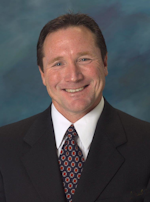There is an old saying – “Sure, that’ll happen when pigs fly” – meaning that something is so ambitious or unreasonable that it will never happen. Consider these “when pigs fly” statements:
- No one will ever break the four-minute mile.
- No one will ever walk on the moon.
- No one will ever score a perfect 10 in gymnastics.
Today, we all know these things happened. Roger Bannister broke the four-minute mile in 1954. Neil Armstrong walked on the moon in 1969. Gymnast Nadia Comaneci scored the first perfect 10 at the 1976 Olympics. What seemed impossible, wasn’t. Barriers were broken and, as a result, new heights in human accomplishment were achieved.
We all believe certain things are true. The earth is round, right? But long ago, conventional wisdom was that the world was flat. Are there things we believe to be true today that might not be? Are we imposing limitations on ourselves when we fail to dream about “what if?” Is there a chance that we will miss opportunities or, even worse, that the world will pass us by? Think of the demise of video rental stores, the Chapter 11 filing by Toys R Us or the state of the taxi business in the world of Uber and Lyft.
Blue-sky thinking – the power of “what if?”
Blue-sky thinking asks, “what if?” It sees what could be. It eliminates barriers, unlocks possibilities and creates energy. Blue-sky thinking thinks big - beyond conventional wisdom to create something new and better.
Ten years ago, most of us could have never imagined the technology we have today. “What if?” thinking has given us the smartphone, an app for everything, Uber and Spotify. Today, we can buy virtually anything online. Soon, we’ll be receiving drone deliveries from Amazon. Can we imagine similar advances for the aviation industry? Absolutely! We’re seeing new ideas and technologies for improving the customer experience.
- Customer-facing robots that can provide passengers on-the-spot assistance and be used to perform a variety of operational tasks, like baggage handling.
- Artificial intelligence, including chatbots, can answer basic passenger questions so agents can focus their attention on more complex human interactions.
- Biometric authentication technology that can enable a traveler’s fingerprints to serve as both a boarding pass and identity document.
Forward thinking leaders are already collaborating across disciplines and with emerging industries and service providers to stay on the cutting edge of innovation. The future looks bright and the sky’s the limit!
Generating blue-sky thinking
For things to happen physically, they must first be envisioned in someone’s mind. The light bulb must go on. For most of us, our day-to-day work focuses on problem solving and job requirements. Under daily pressure, most of us have little time for thinking about “what if?” We are so busy working “in the business” that we fail to take time to work “on the business.” We need to create space to think beyond our borders and to schedule time away to focus on what could be, as opposed to what is.
Blue-sky thinking requires an inquisitive attitude, willingness to question the status quo, and readiness to disagree so we can explore the possibilities. As leaders, we need to model and encourage blue-sky thinking in our organizations, so we can create an environment where team members can grow and do great work.
But how do we do that? Stephen Covey, author of “The Seven Habits of Highly Effective People,” talked about paradigm shifts and that “aha” moment when we see something in a completely different light. He also reasons that every significant breakthrough requires a “break with” the past – moving away from the old ways of looking at things.
As leaders, we can challenge our team members to shift their views of the world and reward them for asking “what if?” Push them to think differently, bring us innovative ideas, and not be afraid to imagine the possibilities. This can be fostered by incorporating blue-sky thinking into staff meetings and individual work programs. Another approach to blue-sky thinking is to imagine life with barriers removed. Look for things that made sense at one time, but no longer do.
Blue-sky thinking and strategic planning
Blue-sky thinking does not replace strategic planning. We still need to comprehensively plan and execute around our vision, values and priorities. Strategic planning answers different questions, designed to evaluate the environment, establish priorities and set action plans and accountability to increase chances of success once an overall direction is established.
Our challenge
Looking back 20+ years, what if no one had said, “What if?”? We would still be booking travel in person or on the phone (instead of online) and standing in long lines to check in. We wouldn’t have in-flight wi-fi, so we could work or watch our own entertainment in flight. We wouldn’t have aircraft redundancies or satellite/GPS technology that has increased airplane safety. Thank goodness there were, and continue to be, blue-sky thinkers asking, “what if?”
“What if?” is such a powerful question. Our challenge as industry leaders is to continue to ask, “what if?” and come up with blue-sky ideas. Maybe pigs will never fly, but by embracing blue-sky thinking, we can ensure the best future for our industry and, most of all, our customers.
Greg Hulsizer is vice president and toll market leader at HNTB Corporation. His expertise includes organization performance optimization as well as program management and operations, toll facility financing, technology procurement and support services. Contact him at [email protected].
Peter Aarons is West Division aviation director and associate vice president for HNTB Corporation. He has more than 25 years of experience in planning, development, design, program and project management, and construction for airports. Contact him at [email protected].





